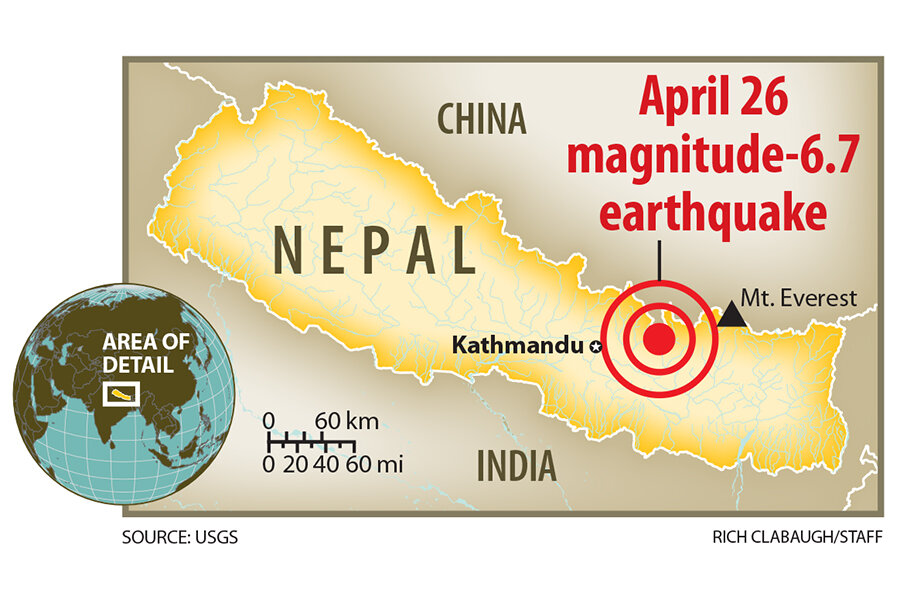Nepal quake: 'The earth hasn't stopped trembling.'
Loading...
| Kathmandu, Nepal
One day after a massive Himalayan earthquake, strong aftershocks continue to sow fear and confusion here. Crowds of people who had spent the night under open skies, barely sleeping, wandered through the city trying to understand the extent of the devastation.
The death toll from the 7.8 magnitude quake, the deadliest since 1934, has risen to 2,254, almost all in Nepal, with nearly 6,000 injuries reported. There is no official tally of missing persons. Beyond densely populated Kathmandu Valley, search and rescue teams are trying to reach towns and villages near the epicenter, some 50 miles northwest. On the slopes of Mount Everest, at least 18 people died in an avalanche triggered by the quake.
Sunday’s aftershocks forced people in the capital to move even farther away from their homes to the few open spaces around.
For some, all hope seems lost. “Our two neighbors died after being trapped under their own house,” says Basanta Bahadur Dangol, a driver who lives in Basantapur whose famed Durbar Square is now mostly a heap of rubble. “We spent the night outside our house. But it looks like the horror will never end. The earth hasn’t stopped trembling ever since yesterday afternoon.”
The devastation has left Nepalese authorities stretched, even as emergency aid begins to arrive from India, China and other countries. “We don’t have equipment to pull out people from quake debris,” says police spokesman Kamal Singh Bam. “At most places, security personnel are searching for missing persons clearing the debris with naked hands.”
Nepal’s army is deploying helicopters for search and rescue. And power has been restored to government buildings and hospitals, though many homes are still cut off, while the international airport in Kathmandu, which closed Saturday, is open.
Focus on survival
Residents occupying the few empty spaces in Kathmandu’s congested streets say they have yet to see a response from the government that they can “feel”. Yet the civic response has also been fitful, say observers. “There have been so many strong aftershocks that all people are thinking about right now is how to survive this,” says Gunaraj Luintel, a former newspaper editor who toured the city Sunday. “They are in fear and confusion.”
Ratna Mani Gupta, a seismologist at the National Seismological Center, says Nepal had not seen a major earthquake in a long time, and therefore panic is only to be expected. “Aftershocks after big quakes are common. But most people living in Nepal today hadn’t experienced one like this, because the last big quake happened over 80 years ago.”
With phones down, rumors are easily spread: One that made the rounds Sunday claimed that a major foreign broadcaster had predicted that an even bigger quake would strike Kathmandu between 3 pm and 5 pm. Panicked residents rushed to safe ground, and even large hotels advised guests to vacate their rooms.
Electricity went out Saturday and most residences are still cut off. As a result, households with water reservoirs on their rooftops can’t pump water. And hotels are turning away guests because of a lack of staff, while some hospitals have erected tents outside.
On the streets, crowds stand watching cranes pull down centuries-old building deemed unsafe. When new aftershocks are felt, people run away helter-skelter.
Everest avalanche
Spring is peak climbing season on Mt. Everest, a major tourist draw for Nepal. Tourism Ministry official Gyanendra Shrestha said at least 18 people had died in Saturday’s avalanche at Mt. Everest Base Camp where hundreds of foreigners were camped to prepare to ascend the summit next month.
Mr. Shrestha said the avalanche had damaged the route built over the treacherous Khumbu Icefall, where a massive avalanche a year ago resulted in the deaths of 16 Sherpa mountain guides. The season was cancelled after that tragedy.
Asked about the prospects for this season, Shrestha replies, “We are talking about a massive earthquake. This is a national tragedy. Let’s not talk about the climbing season right now.”






